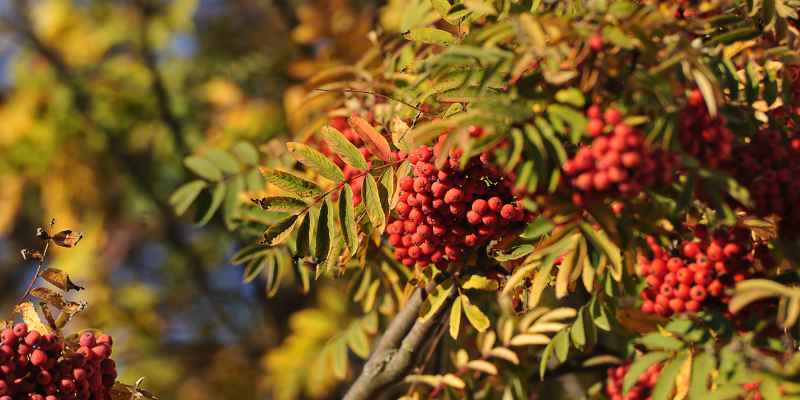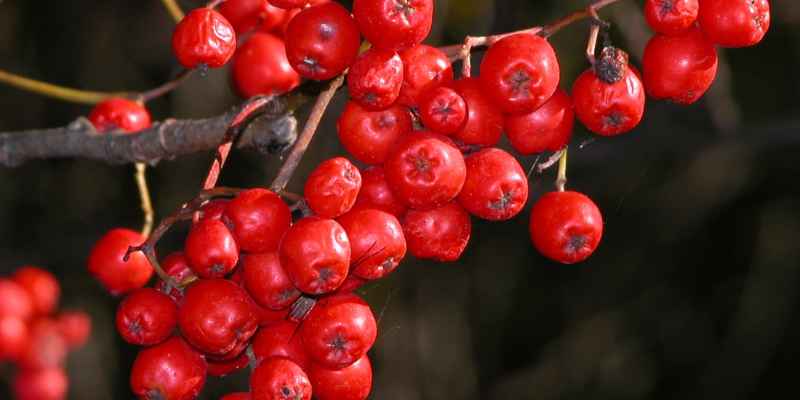The best time to plant a mountain ash tree is in the early spring or late fall. These periods provide optimal conditions for the tree’s establishment and growth.
Mountain ash trees, known for their vibrant foliage and attractive berries, thrive when planted during these seasons. Proper timing ensures that the tree has the opportunity to establish its root system before the onset of harsh weather. By choosing the right time to plant, you can set the stage for a healthy and flourishing mountain ash tree in your landscape.
Introduction To The Mountain Ash Tree
Characteristics
The mountain ash tree, also known as the rowan tree, is a deciduous tree that belongs to the rose family. It is characterized by its pinnate leaves, creamy white flowers, and vibrant red berries. The tree is medium-sized and can reach a height of around 15-30 feet. It is valued for its ornamental beauty and wildlife-attracting properties.
Native Habitats
The mountain ash tree is native to Europe, Asia, and North America. It thrives in a variety of habitats, including forests, woodlands, and mountainous regions. The tree is well-adapted to temperate climates and can tolerate a range of soil types, making it a versatile and resilient species.
Importance Of Timing In Planting
Growth Cycle
Understanding the mountain ash tree’s growth cycle is crucial for successful planting.
Seasonal Considerations
Choosing the right season significantly impacts the tree’s establishment and growth.
Spring Planting Advantages
The best time to plant a mountain ash tree is during the spring season. Spring planting allows the tree to establish its root system before the hot summer months. Additionally, spring planting provides the advantage of having moist soil and cooler temperatures, which helps the tree to thrive.
Spring is the perfect time to plant a mountain ash tree. The warmer temperature and increased sunlight encourage fast growth, and the tree has the whole season to establish its roots before the hot summer months. Spring planting also has several advantages that can help ensure the tree’s success.
Soil Preparation
Before planting, it’s essential to prepare the soil. Mountain ash trees prefer well-draining soil that’s rich in organic matter. You can improve your soil’s quality by adding organic compost or aged manure. Mix it into the top six inches of soil to give the tree’s roots a healthy start.
Early Growth Support
When planting in the spring, it’s essential to provide the tree with support during its early growth. You can use stakes and ties to keep the tree straight and prevent it from bending or breaking in high winds. Remember to remove the stakes after a year or two to prevent them from damaging the bark.
Overall, planting a mountain ash tree in the spring offers several advantages that can help ensure its success. Remember to prepare the soil, provide support during early growth, and maintain the tree’s health through regular watering and pruning. By following these tips, you can enjoy a beautiful and healthy mountain ash tree for years to come.
Fall Planting Benefits

Planting a mountain ash tree in the fall offers several benefits that can contribute to its overall health and growth. The cooler temperatures and moist soil create an optimal environment for root establishment, allowing the tree to develop a strong foundation before winter sets in. Additionally, fall planting allows for ample time for the tree to prepare for the following spring, resulting in robust growth and vibrant foliage.
Root Establishment
During the fall, planting a mountain ash tree enables the roots to establish themselves deeply into the soil, promoting stability and resilience. The cooler weather reduces the stress on the tree, allowing it to focus its energy on root development.
Preparation For Spring
By planting in the fall, the mountain ash tree can dedicate its energy to root growth and establishment, ensuring that it is well-prepared to absorb nutrients and water once spring arrives. This early start sets the stage for vigorous growth, leading to a healthier and more robust tree.
Understanding Your Climate Zone
Understanding your climate zone is crucial when determining the best time to plant a Mountain Ash tree. By identifying your region’s climate characteristics and considering factors such as frost dates and temperature fluctuations, you can ensure optimal growth and survival for your tree.
When it comes to planting a mountain ash tree, understanding your climate zone is crucial for its successful growth and development. Different climate zones have varying temperature ranges, rainfall patterns, and frost dates, which directly impact the ability of the tree to thrive in a particular area. By knowing your climate zone, you can make informed decisions about the best time to plant a mountain ash tree and provide it with optimal growing conditions.
Zone-Specific Recommendations
To determine the best time for planting a mountain ash tree in your specific climate zone, refer to the USDA Hardiness Zone Map. This map divides the United States into 13 different zones based on average annual minimum temperatures. Each zone represents a specific range of temperatures that plants can tolerate. By identifying your zone, you can find zone-specific recommendations for planting and adjusting the planting time accordingly.
Adjusting Planting Time
Depending on your climate zone, you may need to adjust the planting time for your mountain ash tree. In colder regions with shorter growing seasons, it is advisable to plant the tree in early spring to allow it sufficient time to establish its root system before the onset of winter. However, in warmer regions with longer growing seasons, planting in late spring or early fall may be more suitable. By adjusting the planting time, you can ensure that the tree has the best chance of thriving in your specific climate.
In conclusion, understanding your climate zone is essential when determining the best time to plant a mountain ash tree. By referring to the USDA Hardiness Zone Map and considering zone-specific recommendations, you can make informed decisions about the planting time. Adjusting the planting time based on your climate zone will provide the tree with optimal conditions for growth and increase its chances of flourishing in your garden. So, take the time to research your climate zone and give your mountain ash tree the best start possible.
Soil Requirements For Mountain Ash
The best time to plant a Mountain Ash tree is in the early spring or late fall, when the soil is cool and moist. Mountain Ash trees thrive in well-drained, slightly acidic soil with a pH of 5. 5 to 7.
5. It’s important to choose a location with good air circulation to prevent diseases.
If you are planning to plant a mountain ash tree, it is essential to understand the soil requirements for its successful growth. Mountain ash trees prefer slightly acidic to neutral soil with good drainage and fertility. Here are the three key soil requirements that you need to consider before planting a mountain ash tree.
Ph Levels
The pH level of the soil is an essential factor that influences the growth of mountain ash trees. The optimal pH level for mountain ash trees is between 5.5 and 7.0. If the soil is too acidic or alkaline, it can affect the tree’s nutrient uptake and hinder its growth. You can test the soil pH level using a soil testing kit that is readily available at any garden center. If the pH level is not within the optimal range, you can add lime to increase the pH level or sulfur to decrease it.
Drainage
Mountain ash trees prefer well-drained soil that is not waterlogged. Poorly drained soil can lead to root rot, which can be fatal for the tree. To ensure good drainage, plant the tree in a slightly elevated area or add organic matter to the soil to improve its structure. You can also consider planting the tree in a raised bed if the soil is too compact.
Fertility
Mountain ash trees thrive in fertile soil that is rich in organic matter. Before planting the tree, add compost or well-rotted manure to the soil to improve its fertility. You can also consider adding a slow-release fertilizer that is specifically formulated for trees to provide essential nutrients for its growth.
In conclusion, the soil requirements for mountain ash trees are slightly acidic to neutral soil with good drainage and fertility. By ensuring that the soil pH level, drainage, and fertility are optimal, you can provide the best growing conditions for your mountain ash tree, which will result in healthy growth and abundant fruit production.
Caring For Your Newly Planted Tree
To ensure the best growth for your mountain ash tree, it is recommended to plant it in the spring or fall. Proper care is essential, including regular watering and mulching to retain moisture and prevent weed growth. Protect the trunk from damage and consider pruning as necessary to promote healthy growth.
Watering Needs
Proper watering is crucial for ensuring the healthy growth of your mountain ash tree.
Mulching And Pruning
Mulching helps retain moisture and control weeds around the tree. Pruning ensures healthy growth and structure.
Common Pitfalls To Avoid
To ensure successful growth, plant a Mountain Ash tree in the early spring or fall. Avoid planting during extreme weather conditions to prevent stress on the tree. Selecting the right timing is crucial for healthy establishment and long-term flourishing of the Mountain Ash tree.
Incorrect Timing
Planting a Mountain Ash tree at the wrong time can hinder its growth.
Improper Soil Preparation
Mountain Ash trees require well-draining soil for optimal growth.
Incorrect Timing
Planting a Mountain Ash tree at the wrong time can hinder its growth.
Improper Soil Preparation
Mountain Ash trees require well-draining soil for optimal growth.

Frequently Asked Questions
When Is The Best Time To Plant A Mountain Ash Tree?
Planting a Mountain Ash tree is best done in the spring or fall when the soil is moist and temperatures are moderate. This allows the tree to establish its roots before the extremes of summer or winter. Avoid planting during periods of drought or freezing temperatures to give your tree the best chance of thriving.
Conclusion
The best time to plant a Mountain Ash tree is in early spring. By following this timing, you can ensure optimal growth and health for your tree. Remember to choose a sunny spot with well-draining soil for the best results in your gardening endeavors.
Happy planting!


